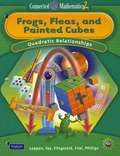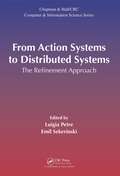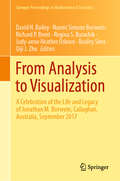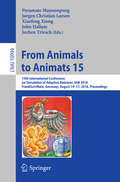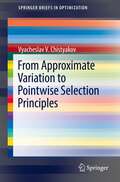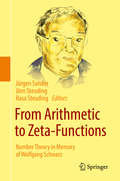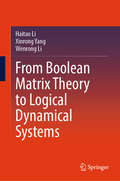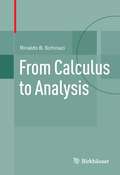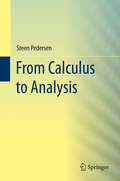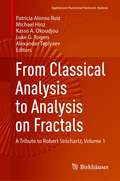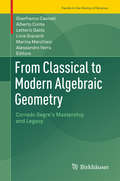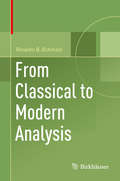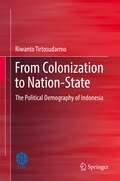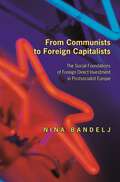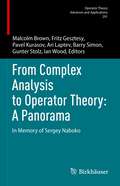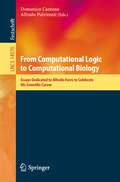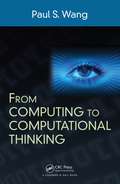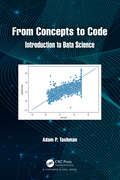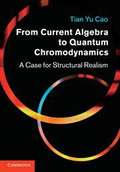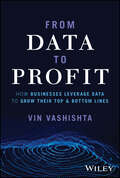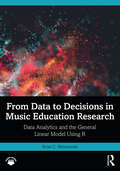- Table View
- List View
Fringe Benefits, Labour Costs and Social Security (Routledge Revivals)
by G. L. Reid D. J. RobertsonOriginally published in 1965, this book is concerned with an important yet neglected part of economic life ‘fringe benefits’ which employers provide for and on behalf of their employees apart from wages and salaries. The book sets out results of an inquiry into the costs of supplementary labour costs for manual workers, with an account of the various influences which help to explain differences in expenditure by different firms. The book then gives comparative figures for Western European countries and considers some of the economic effects of the European levels of supplementary labour costs. The situation in the USA is discussed, as is the relationship of employer-financed welfare schemes and State social security programmes. Chapters on pensions, sick pay and redundancy payments are included as well as those dealing with the history of paid holidays and subsidized welfare facilities such as canteens.
Frogs, Fleas and Painted Cube s: Quadratic Relationships (Texas)
by Glenda Lappan James T. Fey William M. Fitzgerald Susan N. Friel Elizabeth Difanis PhillipsNIMAC-sourced textbook
Frogs, Fleas, and Painted Cubes, Quadratic Relationships
by Glenda Lappan James T. Fey William M. FitzgeraldNIMAC-sourced textbook
From Action Systems to Distributed Systems: The Refinement Approach
by Emil Sekerinski Luigia PetreFormal methods traditionally address the question of transforming software engineering into a mature engineering discipline. This essentially refers to trusting that the software-intensive systems that form our society's infrastructures are behaving according to their specifications. More recently, formal methods are also used to understand propert
From Analysis to Visualization: A Celebration of the Life and Legacy of Jonathan M. Borwein, Callaghan, Australia, September 2017 (Springer Proceedings in Mathematics & Statistics #313)
by Richard P. Brent David H. Bailey Regina S. Burachik Naomi Simone Borwein Judy-anne Heather Osborn Brailey Sims Qiji J. ZhuStudents and researchers from all fields of mathematics are invited to read and treasure this special Proceedings. A conference was held 25 –29 September 2017 at Noah’s On the Beach, Newcastle, Australia, to commemorate the life and work of Jonathan M. Borwein, a mathematician extraordinaire whose untimely passing in August 2016 was a sorry loss to mathematics and to so many members of its community, a loss that continues to be keenly felt. A polymath, Jonathan Borwein ranks among the most wide ranging and influential mathematicians of the last 50 years, making significant contributions to an exceptional diversity of areas and substantially expanding the use of the computer as a tool of the research mathematician. The contributions in this commemorative volume probe Dr. Borwein's ongoing legacy in areas where he did some of his most outstanding work: Applied Analysis, Optimization and Convex Functions; Mathematics Education; Financial Mathematics; plus Number Theory, Special Functions and Pi, all tinged by the double prisms of Experimental Mathematics and Visualization, methodologies he championed.
From Animals to Animats 15: 15th International Conference on Simulation of Adaptive Behavior, SAB 2018, Frankfurt/Main, Germany, August 14-17, 2018, Proceedings (Lecture Notes in Computer Science #10994)
by John Hallam Poramate Manoonpong Jørgen Christian Larsen Xiaofeng Xiong Jochen TrieschThis book constitutes the refereed proceedings of the 15th International Conference on Simulation of Adaptive Behavior, SAB 2018, held in Frankfurt/Main, Germany, in August 2018.The 21 papers presented were carefully reviewed and selected from 39 submissions. They cover the main areas in animat research, including the animat approach and methodology, perception and motor control, action selection and navigation, learning and adaptation, and collective and social behavior.
From Animals to Animats 17: 17th International Conference on Simulation of Adaptive Behavior, SAB 2024, Irvine, CA, USA, September 9–12, 2024, Proceedings (Lecture Notes in Computer Science #14993)
by Jeffrey Krichmar Oliver BrockThis book constitutes the refereed proceedings of the 17th International Conference on Simulation of Adaptive Behavior, SAB 2024, held in Irvine, CA, USA, during September 9–12, 2024. The 26 full papers included in this book were carefully reviewed and selected from 30 submissions. They were organized in topical sections as follows: Bio-Inspired Navigation; Biomimetic Robots; Collective Behavior; Evolutionary Approaches to Adaptive Behavior; Motor Learning and Problem Solving and Decision-Making.
From Approximate Variation to Pointwise Selection Principles (SpringerBriefs in Optimization)
by Vyacheslav V. ChistyakovThe book addresses the minimization of special lower semicontinuous functionals over closed balls in metric spaces, called the approximate variation. The new notion of approximate variation contains more information about the bounded variation functional and has the following features: the infimum in the definition of approximate variation is not attained in general and the total Jordan variation of a function is obtained by a limiting procedure as a parameter tends to zero. By means of the approximate variation, we are able to characterize regulated functions in a generalized sense and provide powerful compactness tools in the topology of pointwise convergence, conventionally called pointwise selection principles. The book presents a thorough, self-contained study of the approximate variation and results which were not published previously in book form. The approximate variation is illustrated by a large number of examples designed specifically for this study. The discussion elaborates on the state-of-the-art pointwise selection principles applied to functions with values in metric spaces, normed spaces, reflexive Banach spaces, and Hilbert spaces. The highlighted feature includes a deep study of special type of lower semicontinuous functionals though the applied methods are of a general nature. The content is accessible to students with some background in real analysis, general topology, and measure theory. Among the new results presented are properties of the approximate variation: semi-additivity, change of variable formula, subtle behavior with respect to uniformly and pointwise convergent sequences of functions, and the behavior on improper metric spaces. These properties are crucial for pointwise selection principles in which the key role is played by the limit superior of the approximate variation. Interestingly, pointwise selection principles may be regular, treating regulated limit functions, and irregular, treating highly irregular functions (e.g., Dirichlet-type functions), in which a significant role is played by Ramsey’s Theorem from formal logic.
From Arithmetic to Zeta-Functions
by Jürgen Sander Jörn Steuding Rasa SteudingThis book collects more than thirty contributions in memory of Wolfgang Schwarz, most of which were presented at the seventh International Conference on Elementary and Analytic Number Theory (ELAZ), held July 2014 in Hildesheim, Germany. Ranging from the theory of arithmetical functions to diophantine problems, to analytic aspects of zeta-functions, the various research and survey articles cover the broad interests of the well-known number theorist and cherished colleague Wolfgang Schwarz (1934-2013), who contributed over one hundred articles on number theory, its history and related fields. Readers interested in elementary or analytic number theory and related fields will certainly find many fascinating topical results among the contributions from both respected mathematicians and up-and-coming young researchers. In addition, some biographical articles highlight the life and mathematical works of Wolfgang Schwarz.
From Boolean Matrix Theory to Logical Dynamical Systems
by Xinrong Yang Haitao Li Wenrong LiThis book offers a systematic platform for the theory of Boolean matrix and its application in logical dynamical systems. As a special kind of non-negative matrix, Boolean matrix has wide applications in graph theory, discrete-event system, game theory, clustering analysis, and so on. Due to the special operations between Boolean matrices, there exist some special mathematical properties for Boolean polynomial and Boolean vector space, which necessitate a general theory of Boolean matrix. Furthermore, logical dynamical systems have received recent attention from systems biology, information security, artificial intelligence, etc. The development of logical dynamical systems needs the mathematical foundation of Boolean matrix and logical matrix. Therefore, it is necessary to explore the relation between Boolean matrix theory and logical dynamical systems. To our best knowledge, there are no published books available on both Boolean matrix theory and logical dynamical systems. This book aims to provide some recent insightful results to meet this gap. It can serve as a textbook for scholars and students of mathematics, cybernetics, biology and artificial intelligence. Especially, the book is an important reference for readers who are interested in Boolean matrix theory and logical dynamical systems.
From Calculus to Analysis
by Rinaldo B. SchinaziThis comprehensive textbook is intended for a two-semester sequence in analysis. The first four chapters present a practical introduction to analysis by using the tools and concepts of calculus. The last five chapters present a first course in analysis. The presentation is clear and concise, allowing students to master the calculus tools that are crucial in understanding analysis. From Calculus to Analysis prepares readers for their first analysis course--important because many undergraduate programs traditionally require such a course. Undergraduates and some advanced high-school seniors will find this text a useful and pleasant experience in the classroom or as a self-study guide. The only prerequisite is a standard calculus course.
From Calculus to Analysis
by Steen PedersenThis textbook features applications including a proof of the Fundamental Theorem of Algebra, space filling curves, and the theory of irrational numbers. In addition to the standard results of advanced calculus, the book contains several interesting applications of these results. The text is intended to form a bridge between calculus and analysis. It is based on the authors lecture notes used and revised nearly every year over the last decade. The book contains numerous illustrations and cross references throughout, as well as exercises with solutions at the end of each section.
From Classical Analysis to Analysis on Fractals: A Tribute to Robert Strichartz, Volume 1 (Applied and Numerical Harmonic Analysis)
by Kasso A. Okoudjou Michael Hinz Patricia Alonso Ruiz Luke G. Rogers Alexander TeplyaevOver the course of his distinguished career, Robert Strichartz (1943-2021) had a substantial impact on the field of analysis with his deep, original results in classical harmonic, functional, and spectral analysis, and in the newly developed analysis on fractals. This is the first volume of a tribute to his work and legacy, featuring chapters that reflect his mathematical interests, written by his colleagues and friends. An introductory chapter summarizes his broad and varied mathematical work and highlights his profound contributions as a mathematical mentor. The remaining articles are grouped into three sections – functional and harmonic analysis on Euclidean spaces, analysis on manifolds, and analysis on fractals – and explore Strichartz’ contributions to these areas, as well as some of the latest developments.
From Classical to Modern Algebraic Geometry
by Letterio Gatto Gianfranco Casnati Alberto Conte Livia Giacardi Marina Marchisio Alessandro VerraThis book commemorates the 150th birthday of Corrado Segre, one of the founders of the Italian School of Algebraic Geometry and a crucial figure in the history of Algebraic Geometry. It is the outcome of a conference held in Turin, Italy. One of the book's most unique features is the inclusion of a previously unpublished manuscript by Corrado Segre, together with a scientific commentary. Representing a prelude to Segre's seminal 1894 contribution on the theory of algebraic curves, this manuscript and other important archival sources included in the essays shed new light on the eminent role he played at the international level. Including both survey articles and original research papers, the book is divided into three parts: section one focuses on the implications of Segre's work in a historic light, while section two presents new results in his field, namely Algebraic Geometry. The third part features Segre's unpublished notebook: Sulla Geometria Sugli Enti Algebrici Semplicemente Infiniti (1890-1891). This volume will appeal to scholars in the History of Mathematics, as well as to researchers in the current subfields of Algebraic Geometry.
From Classical to Modern Analysis
by Rinaldo B. SchinaziThis innovative textbook bridges the gap between undergraduate analysis and graduate measure theory by guiding students from the classical foundations of analysis to more modern topics like metric spaces and Lebesgue integration. Designed for a two-semester introduction to real analysis, the text gives special attention to metric spaces and topology to familiarize students with the level of abstraction and mathematical rigor needed for graduate study in real analysis. Fitting in between analysis textbooks that are too formal or too casual, From Classical to Modern Analysis is a comprehensive, yet straightforward, resource for studying real analysis.To build the foundational elements of real analysis, the first seven chapters cover number systems, convergence of sequences and series, as well as more advanced topics like superior and inferior limits, convergence of functions, and metric spaces. Chapters 8 through 12 explore topology in and continuity on metric spaces and introduce the Lebesgue integrals. The last chapters are largely independent and discuss various applications of the Lebesgue integral. Instructors who want to demonstrate the uses of measure theory and explore its advanced applications with their undergraduate students will find this textbook an invaluable resource. Advanced single-variable calculus and a familiarity with reading and writing mathematical proofs are all readers will need to follow the text. Graduate students can also use this self-contained and comprehensive introduction to real analysis for self-study and review.
From Colonization to Nation-State: The Political Demography of Indonesia
by Riwanto TirtosudarmoThis book examines the history of the political demography of Indonesia. Chronologically, the book begins by introducing the colonization program as a predecessor of transmigration program after independence. The transmigration program, Indonesia’s state policy on migration, is discussed at length in the book but other migration related issues are also presented to show the complex relationship between migration and other social, economic and political issues in Indonesia. In the final chapter, the book discusses the contemporary issues and challenges of disintegration that is facing Indonesia as a nation-state. The book ends with an epilog that shows Indonesia’s political demography challenges in the 21st Century.
From Communists to Foreign Capitalists: The Social Foundations of Foreign Direct Investment in Postsocialist Europe
by Nina BandeljFrom Communists to Foreign Capitalists explores the intersections of two momentous changes in the late twentieth century: the fall of Communism and the rise of globalization. Delving into the economic change that accompanied these shifts in central and Eastern Europe, Nina Bandelj presents a pioneering sociological treatment of the process of foreign direct investment (FDI). She demonstrates how both investors and hosts rely on social networks, institutions, politics, and cultural understandings to make decisions about investment, employing practical rather than rational economic strategies to deal with the true uncertainty that plagues the postsocialist environment. The book explores how eleven postsocialist countries address the very idea of FDI as an integral part of their market transition. The inflows of foreign capital after the collapse of Communism resulted not from the withdrawal of states from the economy, as is commonly expected, but rather from the active involvement of postsocialist states in institutionalizing and legitimizing FDI. Using a wide array of data sources, and combining a macro-level account of national variation in the liberalization to foreign capital with a micro-level account of FDI transactions in the decade following the collapse of Communism in 1989, the book reveals how social forces not only constrain economic transformations but also make them possible. From Communists to Foreign Capitalists is a welcome addition to the growing literature on the social processes that shape economic life.
From Complex Analysis to Operator Theory: In Memory of Sergey Naboko (Operator Theory: Advances and Applications #291)
by Barry Simon Ian Wood Fritz Gesztesy Malcolm Brown Pavel Kurasov Ari Laptev Gunter StolzThis volume is dedicated to the memory of Sergey Naboko (1950-2020). In addition to original research contributions covering the vast areas of interest of Sergey Naboko, it includes personal reminiscences and comments on the works and legacy of Sergey Naboko’s scientific achievements. Areas from complex analysis to operator theory, especially, spectral theory, are covered, and the papers will inspire current and future researchers in these areas.
From Computational Logic to Computational Biology: Essays Dedicated to Alfredo Ferro to Celebrate His Scientific Career (Lecture Notes in Computer Science #14070)
by Domenico Cantone Alfredo PulvirentiAlfredo Ferro’s impact on information technology has traversed diverse domains, encompassing Computational Logic, Data Mining, Bioinformatics, and Complex Systems. After first studying Mathematics at the University of Catania, he received a Ph.D. in Computer Science from NYU in 1981, working under the supervision of Jacob Theodor (Jack) Schwartz. He returned to the University of Catania where he established the Computer Science undergraduate program, served as the coordinator of the Ph.D. program in Computer Science, cofounded the Ph.D. program in Biology, Human Genetics, and Bioinformatics, and retired as a full professor in 2021.Alfredo’s academic career as a computer scientist is characterized by two distinct research phases: Computational Logic until approximately 1995, followed by a notable focus on Data Mining and Bioinformatics. The contributions in this volume reflect the quality and the scope of his personal and collaborative successes.He also taught andinspired many excellent scientists. A pioneering initiative was to establish summer schools for Ph.D. students in 1989, leading to the so-called Lipari School, now the J.T. Schwartz International School for Scientific Research, where Alfredo continues to serve as director. This prestigious series includes schools focused on Computer Science, Complex Systems, and Computational Biology, featuring world-class scientists as lecturers and mentors.
From Computing to Computational Thinking
by Paul WangComputational Thinking (CT) involves fundamental concepts and reasoning, distilled from computer science and other computational sciences, which become powerful general mental tools for solving problems, increasing efficiency, reducing complexity, designing procedures, or interacting with humans and machines. An easy-to-understand guidebook, From Computing to Computational Thinking gives you the tools for understanding and using CT. It does not assume experience or knowledge of programming or of a programming language, but explains concepts and methods for CT with clarity and depth. Successful applications in diverse disciplines have shown the power of CT in problem solving. The book uses puzzles, games, and everyday examples as starting points for discussion and for connecting abstract thinking patterns to real-life situations. It provides an interesting and thought-provoking way to gain general knowledge about modern computing and the concepts and thinking processes underlying modern digital technologies.
From Concepts to Code: Introduction to Data Science
by Adam P. TashmanThe breadth of problems that can be solved with data science is astonishing, and this book provides the required tools and skills fot a broad audience. The reader takes a journey into the forms, uses, and abuses of data and models, and learns how to critically examine each step. Python coding and data analysis skills are built from the ground up, with no prior coding experience assumed. The necessary background in computer science, mathematics, and statistics is provided in an approachable manner.Each step of the machine learning lifecycle is discussed, from business objective planning to monitoring a model in production. This end-to-end approach supplies the broad view necessary to sidestep many of the pitfalls that can sink a data science project. Detailed examples are provided from a wide range of applications and fields, from fraud detection in banking to breast cancer classification in healthcare. The reader will learn the techniques to accomplish tasks that include predicting outcomes, explaining observations, and detecting patterns. Improper use of data and models can introduce unwanted effects and dangers to society. A chapter on model risk provides a framework for comprehensively challenging a model and mitigating weaknesses. When data is collected, stored, and used, it may misrepresent reality and introduce bias. Strategies for addressing bias are discussed. From Concepts to Code: Introduction to Data Science leverages content developed by the author for a full-year data science course suitable for advanced high school or early undergraduate students. This course is freely available and it includes weekly lesson plans.
From Current Algebra to Quantum Chromodynamics
by Tian Yu Cao"The advent of quantum chromodynamics (QCD) in the early 1970s was one of the most important events in twentieth-century science. This book examines the conceptual steps that were crucial to the rise of QCD, placing them in historical context against the background of debates that were ongoing between the bootstrap approach and composite modeling, and between mathematical and realistic conceptions of quarks. It explains the origins of QCD in current algebra and its development through high-energy experiments, model-building, mathematical analysis and conceptual synthesis. Addressing a range of complex physical, philosophical and historiographical issues in detail, this book will interest graduate students and researchers in physics and in the history and philosophy of science"--
From Data To Profit: How Businesses Leverage Data to Grow Their Top and Bottom Lines
by Vin VashishtaTransform your company’s AI and data frameworks to unlock the true power of disruptive new tech In From Data to Profit: How Businesses Leverage Data to Grow Their Top and Bottom Lines, accomplished entrepreneur and AI strategist Vineet Vashishta delivers an engaging and insightful new take on making the most of data, artificial intelligence, and technology at your company. You’ll learn to change the culture, strategy, structure, and operational framework of your company to take full advantage of disruptive advances in tech. The author explores fascinating work being undertaken by firms in the real world, as well as high-value use cases and innovative projects and products made possible by realigning organizational frameworks using the capabilities of new technologies. He explains how to get everyone in your company on the same page, following a single framework, in a way that ensures individual departments get what they want and need. You’ll learn to outline a comprehensive technical vision and purpose that respects departmental autonomy over their core competencies while guaranteeing that they all get the tools they need to make technology their partner. You’ll also discover why firms that have adopted a holistic strategy toward AI and data have enjoyed results far beyond those experienced by those that have taken a piecemeal approach. From Data to Profit demonstrates the proper role of the CEO during an intensive transformation: one of maintaining culture during the change. It offers advice for organizational change, including the 3-Phase Data Organizational Development Framework, the Core Rim 3 Main People Groups Framework, and the way to implement new roles for a Chief Digital Officer and Technical Strategist. Perfect for data professionals, data organizational leaders, and data product and process owners, From Data to Profit will also benefit executives, managers, and other business leaders seeking hands-on advice for digital transformation at their firms.
From Data to Decisions in Music Education Research: Data Analytics and the General Linear Model Using R
by Brian C. WesolowskiFrom Data to Decisions in Music Education Research provides a structured and hands-on approach to working with empirical data in the context of music education research. Using step-by-step tutorials with in-depth examples of music education data, this book draws upon concepts in data science and statistics to provide a comprehensive framework for working with a variety of data and solving data-driven problems. All of the skills presented here use the R programming language, a free, open-source statistical computing and graphics environment. Using R enables readers to refine their computational thinking abilities and data literacy skills while facilitating reproducibility, replication, and transparency of data analysis in the field. The book offers: A clear and comprehensive framework for thinking about data analysis processes in a music education context. An overview of common data structures and data types used in statistical programming and data analytics. Techniques for cleaning, preprocessing, manipulating, aggregating, and mining data in ways that facilitate organization and interpretation. Methods for summarizing and visualizing data to help identify structures, patterns, and trends within data sets. Detailed applications of descriptive, diagnostic, and predictive analytics processes. Step-by-step code for all concepts and analyses. Direct access to all data sets and R script files through the accompanying eResource. From Data to Decisions in Music Education Research offers a reference "cookbook" of code and programming recipes written with the graduate music education student in mind and breaks down data analysis processes and skills in an approachable fashion. It can be used across a wide range of graduate music education courses that rely on the application of empirical data analyses and will be useful to all music education scholars and professionals seeking to enhance their use of quantitative data.
From Data to Decisions in Music Education Research: Data Analytics and the General Linear Model Using R
by Brian C. WesolowskiFrom Data to Decisions in Music Education Research provides a structured and hands-on approach to working with empirical data in the context of music education research. Using step-by-step tutorials with in-depth examples of music education data, this book draws upon concepts in data science and statistics to provide a comprehensive framework for working with a variety of data and solving data-driven problems.All of the skills presented here use the R programming language, a free, open-source statistical computing and graphics environment. Using R enables readers to refine their computational thinking abilities and data literacy skills while facilitating reproducibility, replication, and transparency of data analysis in the field. The book offers: A clear and comprehensive framework for thinking about data analysis processes in a music education context. An overview of common data structures and data types used in statistical programming and data analytics. Techniques for cleaning, preprocessing, manipulating, aggregating, and mining data in ways that facilitate organization and interpretation. Methods for summarizing and visualizing data to help identify structures, patterns, and trends within data sets. Detailed applications of descriptive, diagnostic, and predictive analytics processes. Step-by-step code for all concepts and analyses. Direct access to all data sets and R script files through the accompanying eResource. From Data to Decisions in Music Education Research offers a reference "cookbook" of code and programming recipes written with the graduate music education student in mind and breaks down data analysis processes and skills in an approachable fashion. It can be used across a wide range of graduate music education courses that rely on the application of empirical data analyses and will be useful to all music education scholars and professionals seeking to enhance their use of quantitative data.


